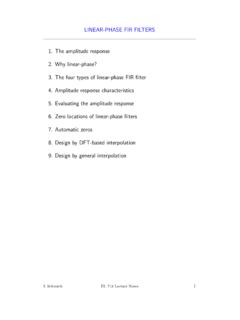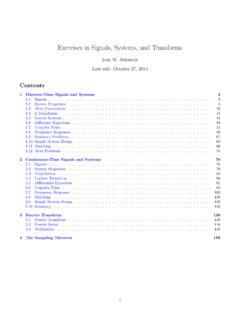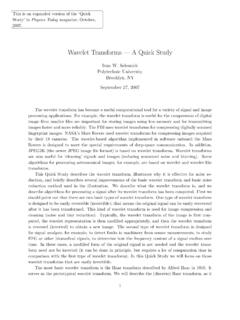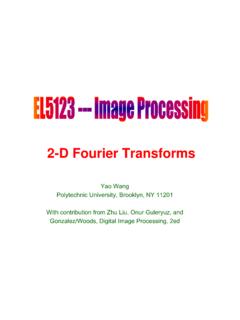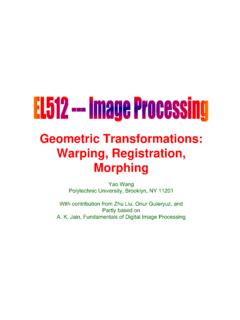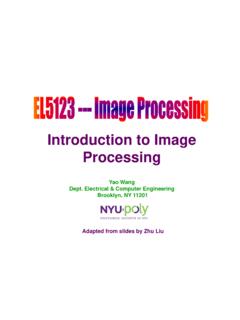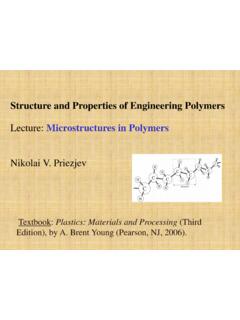Transcription of Physics of MRI
1 Physics of MRIYao WangPolytechnic University, Brooklyn, NY 11201 Based on J. L. Prince and J. M. Links, Medical Imaging Signals and Systems, and lecture notes by Prince. Figures are from the textbook except otherwise MRI PhysicsYao Wang, Polytechnic U., Brooklyn2 Lecture OutlineEL582 MRI PhysicsYao Wang, Polytechnic U., Brooklyn3 Lecture Outline Overview of MRI Nuclear spin properties Precession and Larmor Frequency RF excitation Relaxation Contrast mechanismEL582 MRI PhysicsYao Wang, Polytechnic U., Brooklyn4 Magnetic Resonance Imaging Provide high resolution anatomic structure (as with X-ray CT) Provide high contrast between different soft tissues (X-ray CT cannot) No exposure to radiation and hence safe More complicated instrumentation Takes longer to acquire a scan than CT, more susceptible to patient motionCTMRIPETEL582 MRI PhysicsYao Wang, Polytechnic U., Brooklyn5X-ray projectionMRIEL582 MRI PhysicsYao Wang, Polytechnic U.
2 , Brooklyn6 Basic Principle of MRI The hydrogen (1^H) atom inside body possess spin In the absence of external magnetic field, the spin directions of all atoms are random and cancel each other. When placed in an external magnetic field, the spins align with the external field. By applying an rotating magnetic field in the direction orthogonal to the static field, the spins can be pulled away from the z-axis with an angle \alpha The bulk magnetization vector rotates around z at the Larmorfrequency (precess) The precession relaxes gradually, with the xy-component reduces in time, z-component increases The xy component of the magnetization vector produces a voltage signal, which is the NMR signal we measureEL582 MRI PhysicsYao Wang, Polytechnic U., Brooklyn7 What is Spin? Spin is a fundamental property of nature like electrical charge or mass. Spin comes in multiples of 1/2 and can be + or.
3 Protons, electrons, and neutrons possess spin. Individual unpaired electrons, protons, and neutrons each possesses a spin of or - . Two or more particles with spins having opposite signs can pair up to eliminate the observable manifestations of spin. In nuclear magnetic resonance, it is unpaired nuclear spins that are of importance. EL582 MRI PhysicsYao Wang, Polytechnic U., Brooklyn8 Nuclear Spin A nucleus consists of protons and neutrons When the total number of protons and neutrons (=mass number A) is odd or the total number of protons is odd, a nucleus has an angular momentum (\phi) and hence spin Ex. Hydrogen (1^H) (1 proton), 13^C The spin of a nucleus generates a magnetic filed, which has a magnetic moment (\mu) The spin causes the nucleus behave like a tiny magnet with a north and south poleEL582 MRI PhysicsYao Wang, Polytechnic U., Brooklyn9 Angular momentum vs Magnetic Moment ]EL582 MRI PhysicsYao Wang, Polytechnic U.
4 , Brooklyn10 Nuclear Spin System Collection of identical nuclei in a given sample of material (also known as spin packet, a voxel in the imaged volume) In the absence of external magnetic field, the spin orientations of the nuclei are random and cancel each other When placed in a magnetic field, the microscopic spins tend to align with the external field, producing a net bulk magnetization aligned with the external fieldEL582 MRI PhysicsYao Wang, Polytechnic U., Brooklyn11In the absence of external magnetic fieldHydrogen Nuclei (Protons)Axis of Angular Momentum (Spin), Magnetic MomentFrom Graber, Lecture note for BMI F05EL582 MRI PhysicsYao Wang, Polytechnic U., Brooklyn12 Nuclear Magnetization(low energy state)(high energy state)N-/N+ = e-E/kTEL582 MRI PhysicsYao Wang, Polytechnic U., Brooklyn13 PrecessionmzFrom Graber, Lecture note for BMI F05 Spins PRECESSat a single frequency (w0), but incoherently they are not in phase, so that the sum of x-ycomponents is 0, with net magnetization vector in z directionW0=\gamma B_0: Larmor MRI PhysicsYao Wang, Polytechnic U.
5 , Brooklyn14 Bulk Magnetization at EquilibriumWhich depends on tissue typeEL582 MRI PhysicsYao Wang, Polytechnic U., Brooklyn15 How to make the spins in phase?Irradiating with a rotating magnetic field B_1 of frequency w0, causes spins to precess coherently, or in phase, generating a xy-component EL582 MRI PhysicsYao Wang, Polytechnic U., Brooklyn16 Process Involved in MRI Put patient in a static field B_0 (much stronger than the earth s field) (step 1) Wait until the nuclear magnitization reaches an equilibrium (align with B_0) Applying a rotating magnetic field B_1 (much weaker than B_0) tobring M to an initial angle \alpha with B_0 (rotating freq=Larmorfreq.) M(t) precess around B_0 at Larmor frequency around B_0 axis (z direction) with angle \alpha The component in z increases in time (longitudinal relaxation) with time constant T1 The component in x-y plane reduces in time (transverse relaxation) with time constant T2 Measure the transverse component at a certain time after the excitation (NMR signal) Go back to step 1 By using different excitation pulse sequences, the signal amplitude can reflect mainly the proton density, T1 or T2 at a given voxelEL582 MRI PhysicsYao Wang, Polytechnic U.
6 , Brooklyn17 Evolution of magnetization when a Time varying magnetic field is appliedEL582 MRI PhysicsYao Wang, Polytechnic U., Brooklyn18 M(t) experiences a torque when an external magnetic field B(t) is appliedUsing the right hand rule, M will rotate around z if M is not aligned with zEL582 MRI PhysicsYao Wang, Polytechnic U., Brooklyn19 Cross Product: Review()()()xyzxyzyzzyzxxzxyyxMMMBBBMB MBMB MBMB MB == + + ijkMBijkDirection of MxB follows right hand ruleEL582 MRI PhysicsYao Wang, Polytechnic U., Brooklyn20 Solution under a Static Field with an Initial Angle B(t)=[0,0,B_0] MxB = M_y B_0 i- M_x B_0 j + 0 k dM_x/dt = M_y B_0 dM_y/dt = - M_x B_0 Solving above yields solution in the next slideEL582 MRI PhysicsYao Wang, Polytechnic U., Brooklyn21 Precession Due to a Static Field with an Initial AnglemzThis is the frequency of the photon which would cause a transition between the two energy levels of the spin.
7 B0= , \gamma= MHz/T, v0= MHzEL582 MRI PhysicsYao Wang, Polytechnic U., Brooklyn22 Longitudinal and Transverse ComponentsNo changeRapidly rotatingEL582 MRI PhysicsYao Wang, Polytechnic U., Brooklyn23 Laboratory Frame vs. Rotating Frameyxz, z y x Coordinate system rotated about zaxis at the Larmor rotating M(t) vector appear stationary in the rotating frameEL582 MRI PhysicsYao Wang, Polytechnic U., Brooklyn24 See animation at MRI PhysicsYao Wang, Polytechnic U., Brooklyn25 NMR Signal The rapidly rotating transverse magnetization (M_xy) creates a radio frequency excitation within the sample. If we put a coil of wire outside the sample, the RF excitation will induce a voltage signal. In MRI, we measure this voltage signal. Voltage produced is (Faraday s Law of induction )EL582 MRI PhysicsYao Wang, Polytechnic U., Brooklyn26 Simplification B^r(r)=B^rDDrsPBPThBMBBMVV,V Therefore4, Recallsin2022000000 === EL582 MRI PhysicsYao Wang, Polytechnic U.
8 , Brooklyn27 How do we tilt M to an initial angle? Applying a circularly polarized (rotating) magnetic field B_1(t) in the x-y plane with the same Larmor frequency forces the magnetization vector to tilt down to the x-y plane B_1(t) has two orthogonal components, in x and y directions respectively, and is produced by using quadrature RF coil Simplest envelop B_1,e is a rectangular pulse Motion of M(t) is spiralEL582 MRI PhysicsYao Wang, Polytechnic U., Brooklyn28 Animation of spiral motion Laboratory frame: Rotating frame: MRI PhysicsYao Wang, Polytechnic U., Brooklyn29 Circularly Polarized Magnetic FieldSSNSB0two more magnets, whose fields are orthogonal to B0, that rotate, in opposite directions, at the Larmor frequencyNNEL582 MRI PhysicsYao Wang, Polytechnic U., Brooklyn30 Tip Angle If M is parallel to z-axis before the RF excitation pulse, the tip angle after the excitation (with duration \tau_p) is If B_1^e(t) is rectangular Pulse that leads to \alpha=\pi/2 is called \pi over 2 pulse , which elicits the largest transverse component M_xy, and hence largest NMR signal Pulse that leads to \alpha=\pi is called \pi pulse or inverse pulse, which is used to induce spin echo (later) The excitation pulse (envelop of B_1(t)) is also called an alpha pulse EL582 MRI PhysicsYao Wang, Polytechnic U.
9 , Brooklyn31 RelaxationEL582 MRI PhysicsYao Wang, Polytechnic U., Brooklyn32 Longitudinal Relaxation The magnetization vectors tend to return to equilibrium state (parallel to B_0)=M_0 cos\alpha=0 for \pi/2 pulseEL582 MRI PhysicsYao Wang, Polytechnic U., Brooklyn33x y z B0In the laboratory frame, Mtakes a spirallingpath back to its equilibrium orientation. But here in the rotating frame, it simply rotates in the y -z zcomponent of M, Mz, grows back into its equlibrium value, exponentially:Mz= |M|(1 -e-t/T1)MzMEL582 MRI PhysicsYao Wang, Polytechnic U., Brooklyn34 Transverse Relaxation The strength of the magnetic field in the immediate environment of a 1H nucleus is not homogeneous due to presence of other nucleus (and their interactions) Hence the Larmor frequencies of nearby nuclides are slightly different (some spins faster, some slower) Spin-spin interactions This causes dephasing of the xy components of the magnetization vectors, leading to exponential decay of M_xyEL582 MRI PhysicsYao Wang, Polytechnic U.
10 , Brooklyn35 See animation at Under T2 processes Overall effect of both transverse and longitudinal relaxation: MRI PhysicsYao Wang, Polytechnic U., Brooklyn36 T_2 is called transverse relaxation time, which is the time for M_xyto decrease by 1/e. Also called spin-spin relaxation time T2 is much smaller than T1 For tissue in body, T2: 25-250ms, T1: 250-2500 msEL582 MRI PhysicsYao Wang, Polytechnic U., Brooklyn37 Free induction Decay The voltage signal (NMR signal) produced by decaying M_xy also decays This is called free induction decay (FID), and is the signal we measure in MRIEL582 MRI PhysicsYao Wang, Polytechnic U., Brooklyn38T2 Star Decay Received signal actually decays faster than T_2 (having a shorter relaxation time T_2^*) Caused by fixed spatial variation of the static field B_0 due to imperfection of the magnet Accelerates the dephasing of magnetization vectors Note that T2 is caused by spatial variation of the static field due to interactions of nearby spins The initial decay rate is governed by T_2^* , but the later decay by MRI PhysicsYao Wang, Polytechnic U.
